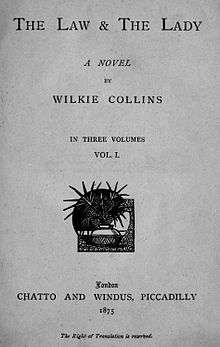The Law and the Lady
 First edition title page | |
| Author | Wilkie Collins |
|---|---|
| Country | United Kingdom |
| Language | English |
| Genre | Mystery |
| Publisher | Chatto & Windus |
Publication date | 1875 |
| Media type | Print (Hardback) |
| Pages | 3 vol. |
The Law and the Lady is a detective story, published in 1875 by Wilkie Collins. It is not quite as sensational in style as The Moonstone and The Woman in White.
Plot summary
Valeria Brinton marries Eustace Woodville despite objections from Woodville's family leading to disquiet for Valeria's own family and friends.
Just a few days after the wedding, various incidents lead Valeria to suspect her husband is hiding a dark secret in his past and she discovers that he has been using a false name. He refuses to discuss it leading them to curtail their honeymoon and return to London where Valeria learns that he was on trial for his first wife's murder by arsenic. He was tried in a Scottish court and the verdict was 'not proven' rather than 'not guilty' implying his guilt but without enough proof for a jury to convict him.
Valeria sets out to save their happiness by proving her husband innocent of the crime. In her quest, she comes across the disabled character Miserrimus Dexter, a fascinating but mentally unstable genius, and his devoted female cousin, Ariel. Dexter will prove crucial to uncovering the disturbing truth behind the mysterious death.
General
Wilkie Collins' earliest career attempt - to read for the bar - informed much of his later work, and he was particularly interested in the marriage, divorce and property laws of England and of Scotland - mysteries and miseries surrounding these laws serve as plot-points in many of his novels, such as the notorious trial of Madeleine Smith, who was accused of poisoning her paramour with arsenic (the verdict was "Not Proven"). In the novel, Collins attacks the Scottish courts for allowing these verdicts, by showing how the defendant's reputation is tarnished even though they were not found legally guilty.[1]
Though Collins is sometimes credited with inventing the detective story, others give that honour to Edgar Allan Poe, whose Murders in the Rue Morgue (1841) was 27 years earlier than Collins' The Moonstone. However, Collins almost certainly began the tradition of female sleuths continued by Agatha Christie with Miss Marple and, in more modern times, V. I. Warshawski, Sara Paretsky's private detective.
References
- ↑ Dougald B. Maceachen, 'Wilkie Collins and British Law', Nineteenth-Century Fiction, Vol. 5, No. 2 (September 1950), pp. 135-138
- Michael Diamond, Victorian Sensation (London: Anthem, 2003) p. 215-216 ISBN 1-84331-150-X
External links
- The Law and the Lady at Project Gutenberg
-
 The Law and the Lady public domain audiobook at LibriVox
The Law and the Lady public domain audiobook at LibriVox
